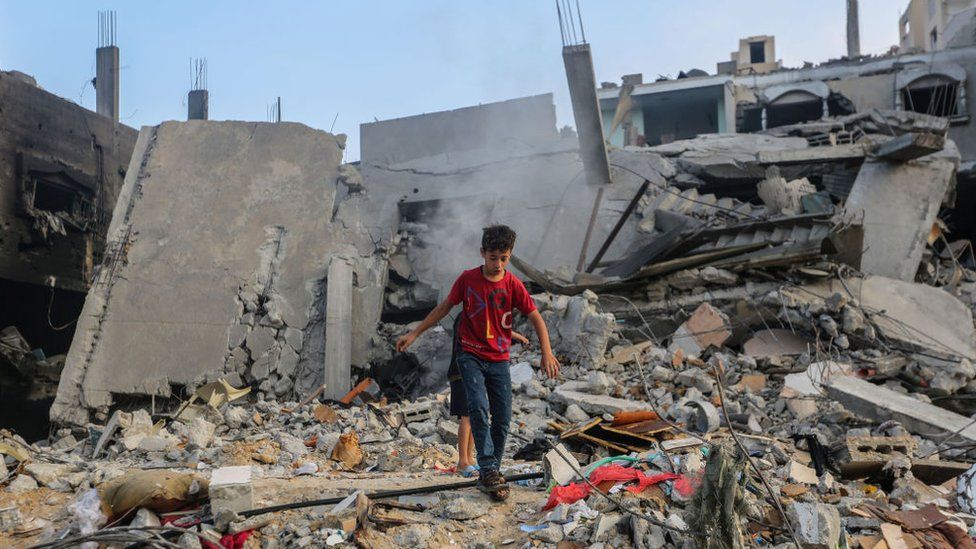
Hamas gunmen launched an unprecedented assault on Israel from the Gaza Strip on 7 October, killing about 1,200 people and taking more than 200 hostages.
Israel responded with air strikes on Gaza and has launched a ground offensive. More than 11,300 people have been killed, according to the Hamas-run health ministry.
What is the goal of Israel’s operation in Gaza?
Israel Defense Forces (IDF) warplanes are bombarding Gaza from the air while its troops and tanks are advancing on the ground. Israel has drafted 300,000 reservists to boost its standing force of 160,000.
Prime Minister Benjamin Netanyahu says Israel has a “clear goal of destroying Hamas’s military and governing capabilities”, as well as freeing the hostages.
Mr Netanyahu has refused calls for a ceasefire unless the hostages are released.
He has also said that Israel will have “overall security responsibility” for the Gaza Strip “for an indefinite period” after the war ends. However, the US has warned him that Israel cannot reoccupy the territory.
Israel believes Hamas’s military wing has about 30,000 members. The group operates from underground tunnels, which it has previously claimed stretch for 500km (310 miles).
What is happening on the ground in Gaza?
The IDF’s focus is on the north of the territory, where fierce fighting is being reported around a number of hospitals.
On Tuesday, the World Health Organization (WHO) said that Al-Shifa, Gaza’s largest hospital, was not functioning anymore, and was “nearly a cemetery”, with bodies piling up inside and out.
Between 2,300 and 2,650 patients, staff and displaced people are thought to be trapped inside, according to the UN. There is particular concern for dozens of premature babies in incubators, and kidney patients needing dialysis.
The BBC’s Rushdi Abu Alouf, who is in the southern city of Khan Younis, has been told a mass grave is being dug for an estimated 170 bodies.
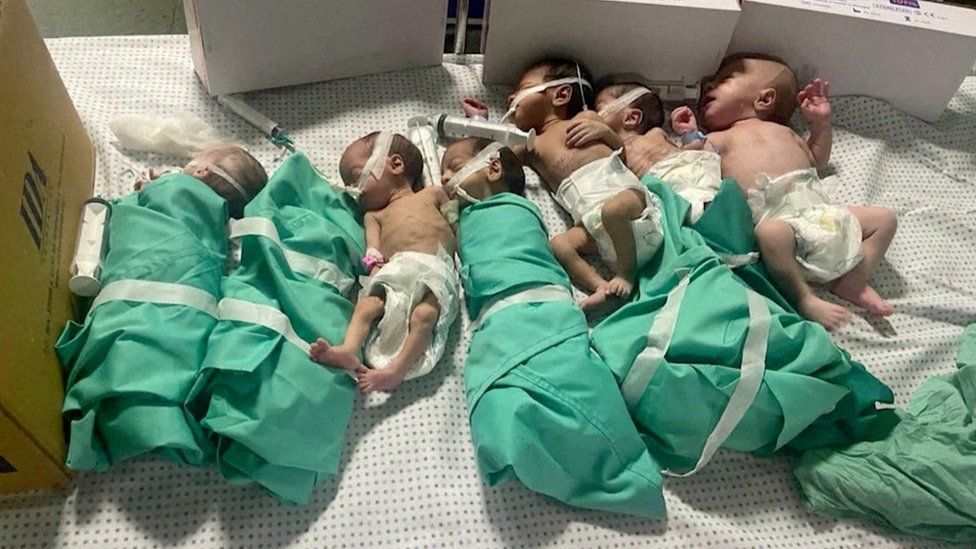
While the IDF has said it does not fire on hospitals, it has stressed that “if we see Hamas terrorists firing from hospitals we’ll do what we need to do”.
It has said its troops have offered humanitarian assistance to Al-Shifa and designated a safe passage from the hospital for civilians to flee southwards.
It has also continued to accuse Hamas of having a command centre underneath Al-Shifa – which both hospital staff and Hamas have denied.
The WHO has said 22 of the 36 hospitals across the entire Gaza Strip are not functional due to a lack of fuel for generators, damage, attacks and insecurity. Those still operating have barely enough supplies to sustain life-saving care.
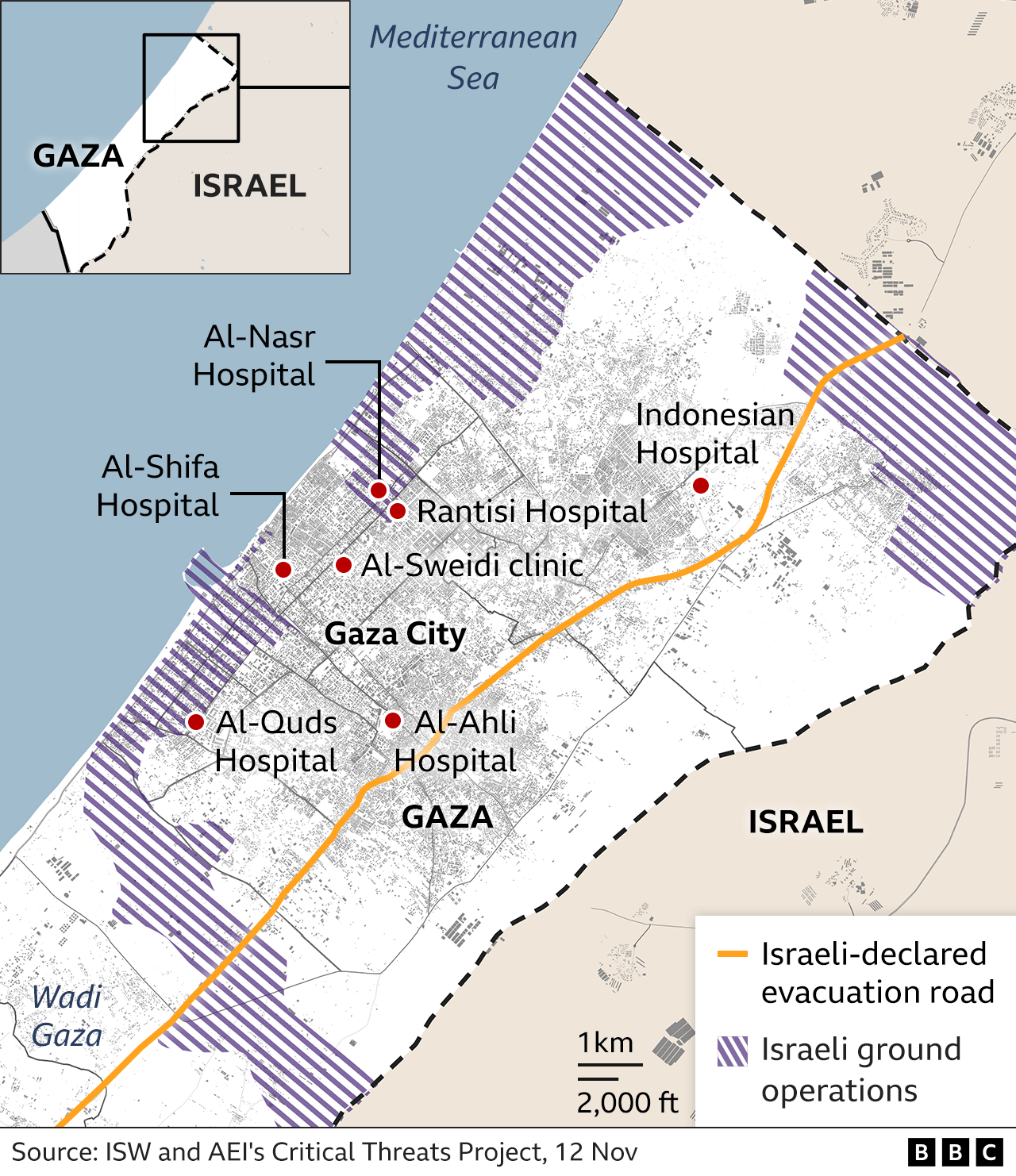
US President Joe Biden has said hospitals in the Gaza Strip must be protected, and called for “less intrusive” action by Israel.
- Gaza hospitals caught on front line of war
- ‘Unclean and unbearable’ – Giving birth under the bombs in Gaza
On Monday, the IDF also said it had carried out raids on Al-Shati refugee camp, Al-Quds University and Abu Bakr mosque.
In total, the IDF said its aircraft and ground forces had conducted 4,300 strikes, hitting hundreds of anti-tank missile launch posts, 300 tunnel shafts and 3,000 “terrorist infrastructure sites”, and that 44 of its soldiers had so far been killed during the ground operation.
The IDF has repeatedly warned Palestinians in the north of Gaza to leave their homes for their own safety and head south of the Wadi Gaza river, but has also continued to carry out air strikes in the south.
https://emp.bbc.com/emp/SMPj/2.50.8/iframe.htmlMedia caption,
Watch: Civilians leave northern Gaza on foot
The UN has said an estimated 200,000 have fled the north since 5 November. But it is increasingly concerned by overcrowding and limited access to shelter, food and water, in the south.
It has also warned that hundreds of thousands of people, who are either unwilling or unable to leave, remain in the north and are struggling to secure the minimum amount of water and food to survive.
What is the humanitarian situation in Gaza?
The heads of all the major UN agencies have called for an “immediate humanitarian ceasefire”, as well as the unconditional release of hostages.
They said “cutting off 2.2 million Palestinians from food, water, medicine, electricity and fuel” was an “outrage”, and that more than 29,000 injured people “require immediate treatment”.
Unrwa, the UN agency for Palestinian refugees, has said 1.5 million Gaza residents have been displaced, and that 778,000 are sheltering at its facilities. Another 150,000 are taking refuge in hospitals and other public buildings.
On Monday, the IDF said it had paused its military operations eight times in the preceding five days, in areas north-east of Gaza City and the southern city of Rafah.
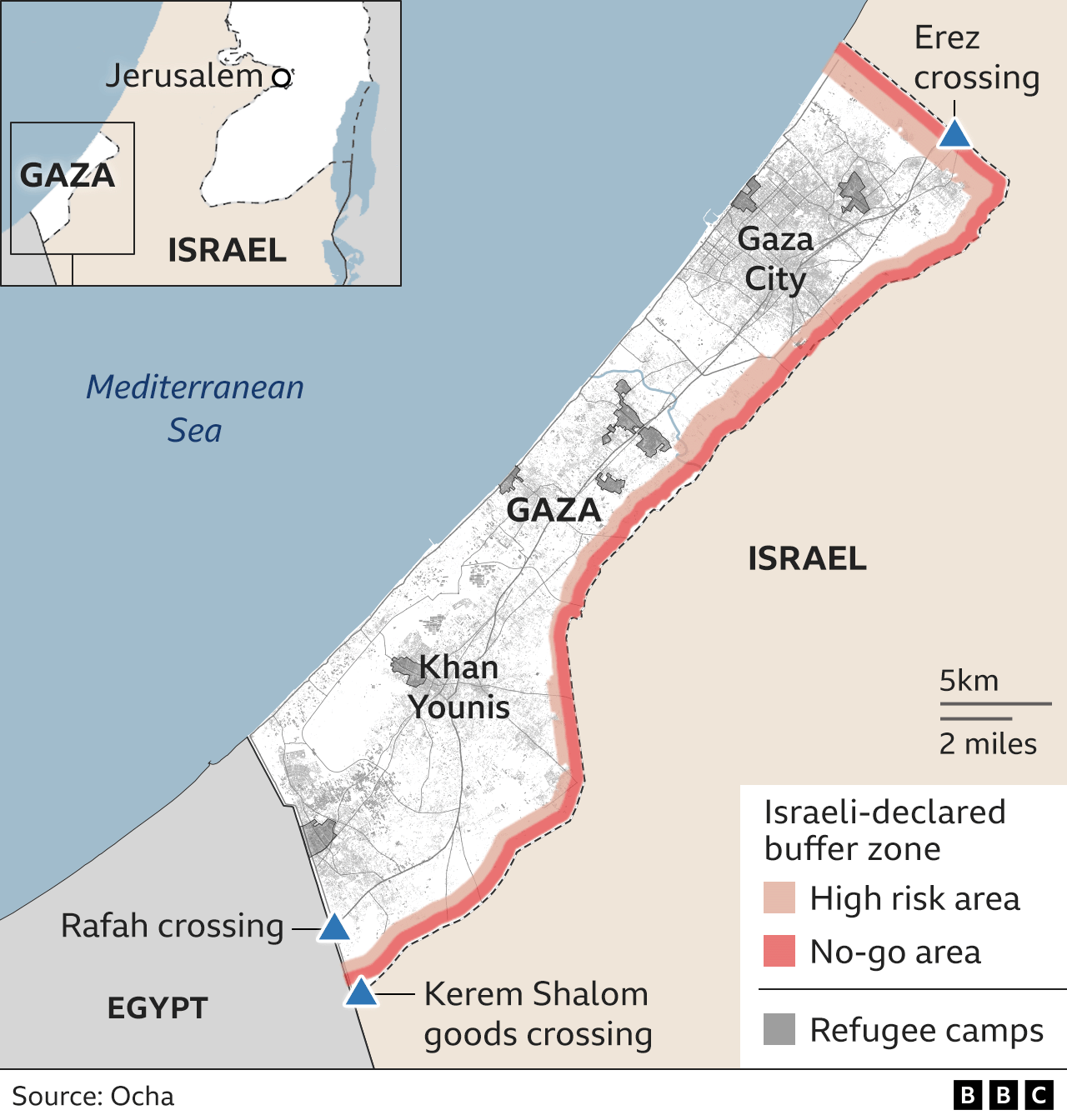
Phone and internet services have been repeatedly cut, leaving people unable to call for ambulances or to contact the outside world.
The Rafah border crossing into Egypt, to the south, is the only functioning route for people and goods to leave or enter Gaza.
The crossing reopened for aid supplies on 21 October, but only a small fraction of the 500 lorry-loads which used to arrive every day is currently making it into Gaza.
Fuel shortages mean little aid is reaching Gaza City and the north.
The border reopened again for people to leave Gaza on 1 November, and hundreds of injured people and foreign passport holders, including more than 100 UK citizens, have since crossed into Egypt, although many more remain. The crossing has shut for short periods several times since reopening.

More on Israel-Gaza war
- Follow live: Latest updates
- From Gaza: ‘So crowded we can’t even sleep on our backs’: Gaza shelters at breaking point
- From Israel: How much closer is Israel to its goal in Gaza?
- Analysis: Bowen: Why this Israel-Gaza war is different
- Explained: The Israel-Palestinian conflict

Who are the hostages?
The IDF says Hamas is holding 242 hostages in Gaza.
The WHO is “gravely concerned” about their condition – especially those who are children, elderly or in poor health – and has called for their immediate release.
It is thought Hamas may have taken the hostages to pressurise Israel into freeing some, or all, of the estimated 5,100 Palestinians who were held in Israeli prisons at the start of October.
Hamas says it has hidden the hostages across Gaza, with some in its tunnel network.
It claims that hostages have been killed by Israeli air strikes, although this cannot be independently verified.
On Tuesday, the IDF confirmed the death in captivity of a 19-year-old soldier who was among the hostages, Corporal Noa Mariciano.
Palestinian Islamic Jihad, the second biggest armed group in Gaza, released last week a video of two Israeli hostages in Gaza – a woman in her 70s called Hanna Katsir, and a teenage boy.
It said it would let them go them for humanitarian and medical reasons if “appropriate measures” were met.
Four hostages have been released by Hamas so far: American-Israeli mother and daughter Judith and Natalie Raanan and two elderly Israeli women, Nurit Cooper and Yocheved Lifschitz.
Separately, the IDF said Private Ori Megidish was rescued during ground operations in Gaza.
What is Hamas and what does it want?
Hamas is a Palestinian group which has ruled the Gaza Strip since 2007. The group is sworn to Israel’s destruction and wants to replace it with an Islamic state.
Hamas has fought several wars with Israel since it took power, firing thousands of rockets into Israel, and carrying out other deadly attacks.
In response, Israel has repeatedly attacked Hamas with air strikes. In 2008 and 2014, it also sent troops into Gaza.
Together with Egypt, Israel has blockaded the Gaza Strip since 2007 for what it describes as security reasons.
Hamas – or in some cases its military wing, the Izzedine al-Qassam Brigades – has been designated a terrorist group by Israel, the United States, the European Union and the UK, as well as other powers.
Iran backs the group, providing it with funding, weapons and training.
Why is there a war in Gaza now?
On 7 October, hundreds of Hamas gunmen crossed from the Gaza Strip into southern Israel by breaking through the heavily-fortified perimeter fence, landing by sea, and using paragliders.
It was the most serious cross-border attack Israel has faced in more than a generation.
The gunmen killed about 1,200 people, most of them civilians, in a series of raids on military posts, kibbutzim and a music festival, and took hostages back into Gaza. Previous estimates put the death toll at more than 1,400.
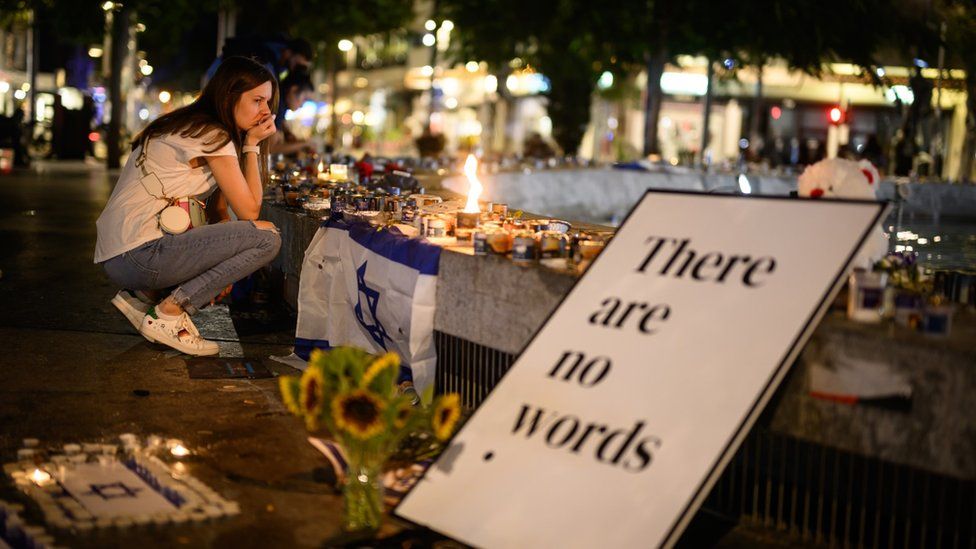
Mr Netanyahu said after the attack that Israel was at war, and vowed that Hamas would “pay an unprecedented price”.
Given the significant resources of Israel’s security services, it was astounding that the attack by Hamas was not anticipated, according to the BBC’s security correspondent Frank Gardner.
The attack came at a time of soaring Israeli-Palestinian tensions.
This year has been the deadliest on record for Palestinians who live in the Israeli-occupied West Bank, which could have motivated Hamas to strike Israel.
Hamas might also have been seeking to score a significant propaganda victory to boost its popularity among ordinary Palestinians.
What is the Gaza Strip and how big is it?
The Gaza Strip is a 41km (25-mile) long and 10km-wide territory located between Israel, Egypt and the Mediterranean Sea.
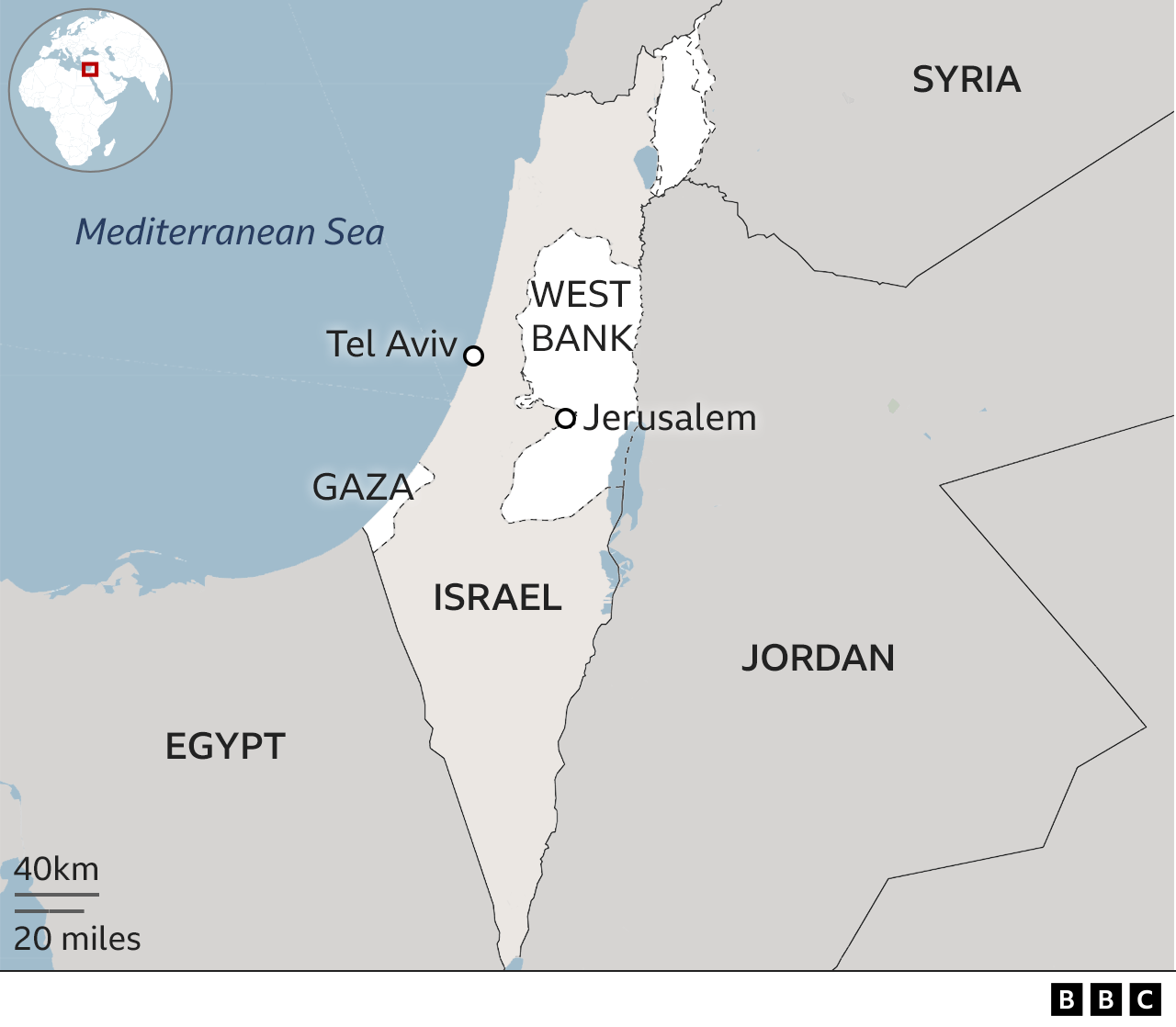
Originally occupied by Egypt, Gaza was captured by Israel during the 1967 Six-Day War.
Israel withdrew its troops and around 7,000 settlers from the territory in 2005.
The enclave is home to 2.23 million people and has one of the highest population densities in the world.
Just over 75% of Gaza’s population – some 1.7 million people – are registered refugees or descendants of refugees, according to the UN.
Before the latest conflict, more than 500,000 people lived in eight crowded camps located across the Strip.
Israel controls the air space over Gaza and its shoreline, and has strictly controlled the movement of people and goods.
What is Palestine?
The West Bank and Gaza are known as the Palestinian territories. Along with East Jerusalem and Israel, they formed part of a land known as Palestine from Roman times until the mid-20th Century.
These were also the lands of Jewish kingdoms in the Bible, and are seen by many Jews as their ancient homeland.
Israel was declared a state in 1948, although the land is still referred to as Palestine by those who do not recognise the country’s right to exist.
The Palestinian president is Mahmoud Abbas, also known as Abu Mazen. He is based in the West Bank, which is under Israeli occupation.
He has been the leader of the Palestinian Authority (PA) since 2005, and represents the Fatah political party, a bitter rival of Hamas.
